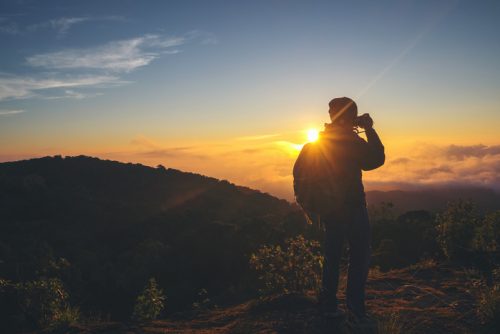This content was published: August 3, 2018. Phone numbers, email addresses, and other information may have changed.
Take Your Camera Outside with Curiosity and Confidence (5 Secrets for Better Photographs)
PCC Community Ed

Photography is a highly subjective art form with many variables. Your approach to each photo is dictated by your subject, which is the lead character in the story you create with your image. The technology you choose, paired with lighting, angles, focus, filters and printing techniques (among seemingly endless others) can create a wildly varying finished product – and that’s where the fun comes in to play.
But as with other art forms, photography requires an understanding of basic principles – plus plenty of practice and a bit of creativity. We’ll review seven simple tips for composing your photos to help you master photography and tell a story that makes people feel as if they are a part of it.
1. Follow the Rule of Thirds.
Many amateur photographers have a tendency to center their subject in the frame of their photograph. However, it makes for a much more interesting shot to use the rule of thirds when composing your photo. Think of your frame as a grid, with three columns and rows, like a tic-tac-toe board. Place your subject at the intersection of a vertical and horizontal line in the grid. By using this technique, the viewer’s eye is drawn into the photo, giving the image more energy and drama.
2. Avoid Distracting Backgrounds.
To ensure that the focus of your image is your subject, choose an uncluttered background, if possible. Look for contrast. For example, using a dark background with a brightly colored subject will make the subject pop. For situations where you are not able to choose the background for your subject, use your camera’s selective focus setting to slightly blur the background and keep the attention on your subject.
3. Know Your Flash Range.
For indoor photography, natural light is often insufficient. Keep in mind, however, that even when using a flash, you can end up with photos that are too dark. It’s important to understand the limits of your camera’s flash. For many digital cameras, the maximum flash range is about 15 feet.
4. Try a New Angle.
Add visual appeal to your photo by using an unusual angle (as pioneered by many would-be Instagram celebs). For example, instead of using an eye-level view, try a bird’s-eye view by getting high above your subject and shooting straight down, or a high-angle view, still shooting from above your subject but at a softer angle. Or get low and shoot from underneath your subject. This angle makes your subject seem larger and is especially good if the most interesting features are underneath. For a bug’s-eye view, get really low. Consider lying on your back and shooting straight up.
5. Avoid Harsh Light.
Bright light can create dark shadows and cause your subject to squint. This can be an issue particularly in the summer months, with the high angle of the sun. Try to schedule shoots just before sunrise or just after sunset — the golden hours. Also experiment with diffusers to soften the light in your shots.
Bonus Tip!
Focus on learning more than just the equipment. The very best tool for great photography is education. PCC Community Ed offers a number of photography classes on subjects from lighting to editing, perfect for both the beginner and those looking to take their photography to the next level.
